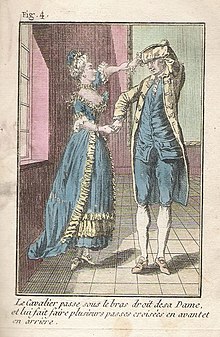
Back رقصة ألمانية Arabic Алеманда Bulgarian Alemanda Catalan Аллеманда CE Allemanda Czech Allemande German Αλεμάντ Greek Alemando EO Alemanda Spanish Allemande ET

An allemande (allemanda, almain(e), or alman(d), French: "German (dance)") is a Renaissance and Baroque dance, and one of the most common instrumental dance styles in Baroque music, with examples by Couperin, Purcell, Bach and Handel. It is often the first movement of a Baroque suite of dances, paired with a subsequent courante, though it is sometimes preceded by an introduction or prelude.[1] Along with the waltz and ländler, the allemande was sometimes referred to by the generic term German Dance in publications during the late 18th and early 19th centuries.[2]
A quite different, later, Allemande, named as such in the time of Mozart and Beethoven, still survives in Germany and Switzerland and is a lively triple-time social dance related to the waltz and the Ländler.[3]
The name "Allemande" comes from the name of Germany in French.
- ^ Meredith Ellis Little; Suzanne G. Cusick (2001). "Allemande [allemand, almain, alman, almond] (Fr.: 'German [dance]'; It. alemana, allemanda)". Grove Music Online. Oxford University Press. doi:10.1093/gmo/9781561592630.article.00613.
- ^ Cliff Eisen (2001). "German Dance (Ger. Deutsche, Deutscher Tanz, Teutsche; Fr. allemande; It. tedesco)". Grove Music Online. Oxford University Press. doi:10.1093/gmo/9781561592630.article.10937.
- ^ Scholes P., 1970, article: Allemande.